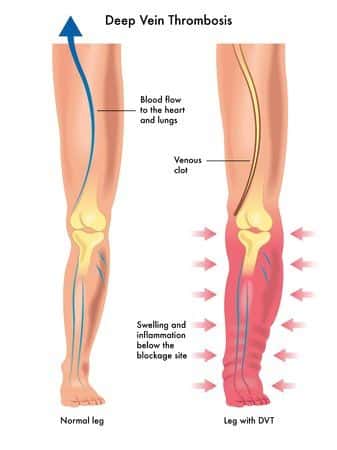Misdiagnosis of Deep Vein Thrombosis by Emergency Medicine Physician
Updated on
This case involves a sixty-one-year-old male who entered an emergency room complaining of leg cramps and swelling in his upper thigh. He has been highly active throughout his life, playing basketball and tennis on a weekly basis. His medical history provided information of a heart attack, hence his new active lifestyle. The pain had been reoccurring and the patient indicated he took over the counter ibuprofen to manage the pain. The emergency medicine physician examined the patient’s knee joint and sent him in for an x-ray. The results showed that he was suffering from osteoarthritis and he was given NSAIDs. The patient was sent home and the swelling and pain subsided. Three days later, the patient began to cough up blood. He complained of back and chest pain, and his wife explained that he could not stand. He was rushed to the hospital and was pronounced dead on arrival. An autopsy revealed that the patient had passed from a pulmonary embolism.
Question(s) For Expert Witness
1. Did the emergency medicine physician follow the proper standard of care for a sixty-one-year-old patient with a history of a heart attack?
Expert Witness Response
 The emergency medicine physician failed to identify the deep vein thrombosis, which was the cause of the pulmonary embolism that killed the patient. The patient’s leg cramps and swelling stemmed from a blood clot, although the misdiagnosis of osteoarthritis was sufficient for the emergency medicine physician. An ultrasound or venography should have been ordered which would have diagnosed the DVT. In this case, only an x-ray scan was completed, which did not catch the clot. The patient also had a history of a heart attack, which is a common occurrence for patients who are diagnosed with DVT. The prescription NSAIDs may have helped with the swelling, but the clot would have to be stabilized or removed in order for guaranteed survival. This could have accomplished with Herapin injections, Coumadin pills, and if necessary clot-busting drugs. This blood clot traveled to the patient’s lungs, which caused the pulmonary embolism. The pulmonary embolism had similar symptoms to a heart attack, but at the point when the patient reached the hospital, it would have been untreatable. Had the DVT been diagnosed earlier, the patient most likely would have survived.
The emergency medicine physician failed to identify the deep vein thrombosis, which was the cause of the pulmonary embolism that killed the patient. The patient’s leg cramps and swelling stemmed from a blood clot, although the misdiagnosis of osteoarthritis was sufficient for the emergency medicine physician. An ultrasound or venography should have been ordered which would have diagnosed the DVT. In this case, only an x-ray scan was completed, which did not catch the clot. The patient also had a history of a heart attack, which is a common occurrence for patients who are diagnosed with DVT. The prescription NSAIDs may have helped with the swelling, but the clot would have to be stabilized or removed in order for guaranteed survival. This could have accomplished with Herapin injections, Coumadin pills, and if necessary clot-busting drugs. This blood clot traveled to the patient’s lungs, which caused the pulmonary embolism. The pulmonary embolism had similar symptoms to a heart attack, but at the point when the patient reached the hospital, it would have been untreatable. Had the DVT been diagnosed earlier, the patient most likely would have survived.
Subscribe to our newsletter
Join our newsletter to stay up to date on legal news, insights and product updates from Expert Institute.
Sign up nowFind an expert witness near you
What State is your case in?
Subscribe to our newsletter
Join our newsletter to stay up to date on legal news, insights and product updates from Expert Institute.


